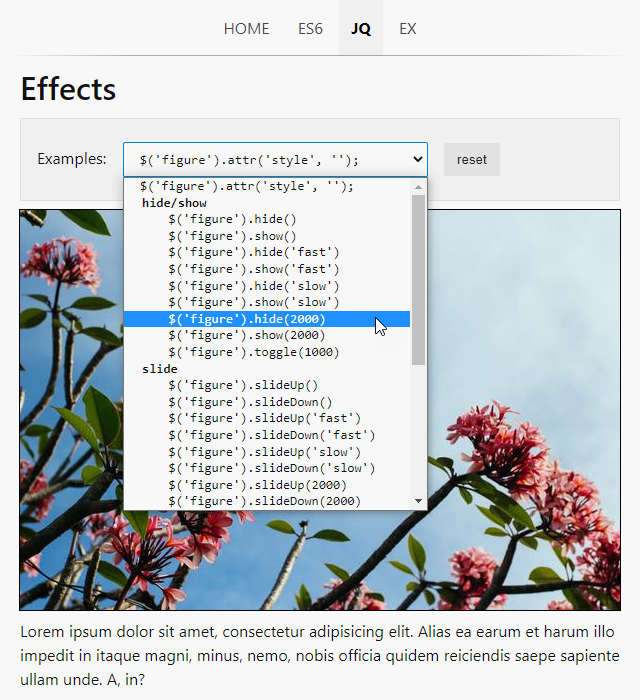# Animation (effects)
- Animations can be created with either pure CSS or with JavaScript, but each has its pros and cons:
- Use CSS transitions and keyframe animations for small, self-contained states of UI elements
- Examples: a button hover animation, showing a tooltip, sliding in a navigation menu, ...
- Use JavaScript animations for complex animations and rich interactivity
- Examples: event based animations (stop-pause-reverse animations on click events), complex sequences of timeline animations, ...
- Use CSS transitions and keyframe animations for small, self-contained states of UI elements
- Vanilla JavaScript has a built-in Web Animations API (opens new window)
that is well-supported in all modern browsers
(Note: we haven't discussed this API in this course) - jQuery also has some built-in methods (e.g.
animate()(opens new window)) for simple to advanced animations
REMARKS
- jQuery's animations are slow compared to CSS animations and the Web Animation API
- When speed is (really) important, we recommend the GSAP Animation Platform (opens new window)
# Effects
- In this section we only discuss the basic built-in animations (so-called effects) with jQuery
- The first (optional) parameter of all these effects corresponds to the duration of the effect in
msor by using the wordsfast(= 200ms) orslow(= 600ms)- The default duration for every effect (except for
show/hide/toggle) is 400ms
- The default duration for every effect (except for
- The last (optional) parameter of all these effects is a callback function that runs once the effect is completed
- Open jQuery/effects/effects.html and look at the behavior of some basic effects

# Show/hide
| effect | description |
|---|---|
<element>.show() (opens new window) | show the matched <element> |
<element>.hide() (opens new window) | hide the matched <element> |
<element>.toggle() (opens new window) | show/hide the matched <element> |
# Slide
| effect | description |
|---|---|
<element>.slideUp() (opens new window) | show the matched <element> with a sliding motion |
<element>.slideDown() (opens new window) | hide the matched <element> with a sliding motion |
<element>.slideToggle() (opens new window) | show/hide the matched <element> with a sliding motion |
# Fade
| effect | description |
|---|---|
<element>.fadeIn() (opens new window) | show the matched <element> by fading it's opacity to 100% (opaque) |
<element>.fadeOut() (opens new window) | hide the matched <element> by fading it's opacity to 0% (transparant) |
<element>.fadeToggle() (opens new window) | show/hide the matched <element> by fading it's opacity |
<element>.fadeTo() (opens new window) | adjust the opacity of the matched element |
# Delay
- The
delay()method allows us to delay the execution of functions that follow it in the queue, e.g.
$('div').slideUp().delay(500).slideDown()Copied!
1
# Example
# Slideshow
- Open jquery/effects/slideshow.html (opens new window) and jquery/effects/slideshow.js
- Every 4 seconds, a new, random image is placed inside the
figuretag- hide the
figuretag with aslideUpeffect - empty the
figuretag - append the new random image to the
figuretag - wait 500ms, so the image can be loaded in the background
- show the
figuretag with aslideDowneffect
- hide the
HTML
jQuery
<div class="border-gray"> <figure> <img src="https://picsum.photos/id/151/600/400" alt="image 151" /> </figure> </div>Copied!
1
2
3
4
5
2
3
4
5